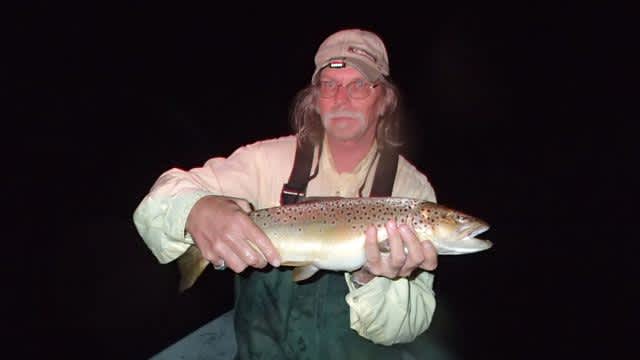The Au Sable River: Trout Fishing Excellence
Bob Gwizdz 05.27.15

Few trout streams anywhere in the country are as legendary as Michigan’s Au Sable River. Known worldwide for its excellent fly hatches, good wading conditions, and fine trout populations, the Au Sable River attracts angers from around the globe throughout the year.
But the Au Sable River system is a complex environment offering everything from resident brook trout to migratory steelhead. There are 180 miles of blue-ribbon trout stream in the Au Sable watershed, offering anglers everything from top-notch dry-fly fishing to satisfactory bait-dunking with plenty of water open to artificials-only, too.
The most storied stretch of the Au Sable is the Holy Water, the nine-mile stretch from Burton’s Landing just downstream of Grayling to Wakeley Bridge. This gently flowing, highly wade-able stretch is bisected by Stephan Bridge, where Gates Au Sable Lodge, a full-service Orvis Shop, is legendary in its own right. This stretch—open year-round to catch-and-release, fly-fishing only—offers good access and its rocky bottom produces dependable fly hatches from May to October. Hendricksons, olives, caddis, and tricos offer plenty of opportunity. But it is heavily fished and the trout are well-educated.
The six-mile run below Wakeley Bridge to McMaster’s Bridge is wider, slower, and more sandy-bottomed. It’s popular for float trips, offering good fishing for big brown trout. Below McMaster’s, down to Mio Pond, the gradient picks up, the bottom return to gravel, and the river widens even more. This stretch is noted for both big browns and the famous hex hatch, which occurs after dark and brings the big browns out to feed at night.
My favorite stretch is below Mio Pond, where the first several hundred yards are open to all methods of gear and bait anglers congregate to pick off the stocked trout, which the Department of Natural Resources provides in big numbers. But below power lines, the regulations require artificials-only—and here a mix of fly fishermen and lure-chunkers target the brown trout that grow to lunker size. This stretch is commonly called the Trophy Water and truly memorable brown trout can be found here. It is popular with float fishermen—it’s wide, big water, not easily waded in some stretches—who catch giant browns and nice rainbows, too. There’s a good Hendrickson hatch early in the season and often an almost too-bountiful white fly (ephorons) hatch late in the season that produces excellent activity until the spinner fall becomes so heavy that the odds of connecting with a trout become long.
But personally, I like the stretch below Mio especially on cloudy or rainy days when big streamers or Rapalas attract giant brown trout.
The last roughly 60 miles of river is interrupted by impoundments and fish populations and becomes less trouty and more diverse. There are said to be big browns below Alcona Dam, for instance, but my personal experience there is there is excellent fishing for smallmouth bass. Below Foote Dam, the final stretch running into Lake Huron, the river is noted for bass, walleye, and, of course, steelhead from late fall through spring.
But that’s just the mainstream.
Chris Lessway, a well-known fishing guide, headquarters his operation out of Fuller’s Outing Club on the North Branch of the Au Sable. The flies-only stretch offers excellent hatches and easy wading; there are tons of brook trout in the North Branch with some really big browns that tuck up under the log dams and come out to feed on the evening hatches. They tend to target the brown drakes, which usually hatch out around the first week of June, depending on the spring weather.
“The brown drakes bring out the bigger fish and if you hit it when it’s going, it can be incredible,” Lessway said.
The peak of fishing is the hex hatch, but after the hexes, there’s a good trico hatch and there’s an almost guaranteed spinner fall within a couple of hours of the hatch.
The South Branch offers good fishing for big browns, with lots of access, especially along the Mason Tract. There’s good wading on the upper portions of the South Branch and big fish are fairly common during the hex hatch and afterwards, when anglers fish big, waking flies—like mice—after dark. The South Branch is often crowded; guides like Lessway, who offer float trips, tend to fish downstream from Smith Bridge to the confluence of the main stream.
“There’s not a whole lot of wading access points there, so you don’t have to worry about too many people,” Lessway said.
Less well-known, but offering good fishing, too, is the East Branch. There’s access just north of Grayling and I’ve enjoyed good fishing for brook trout—and some browns—without too much competition from other anglers.
For more information on Michigan fishing go to michigan.org. Click here to purchase a Michigan fishing license online.
This article was produced in partnership with Pure Michigan.

